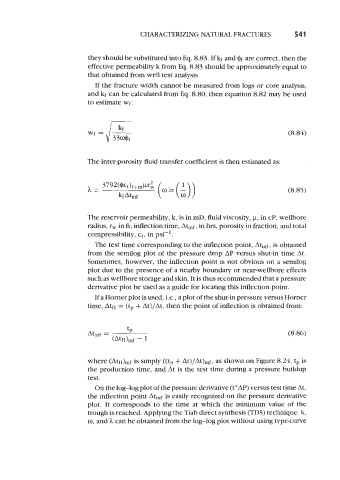Page 574 - Petrophysics
P. 574
CHARACTERIZING NATURAL FRACTURES 541
they should be substituted into Eq. 8.83. If kf and $f are correct, then the
effective permeability k from Eq. 8.83 should be approximately equal to
that obtained from well test analysis.
If the fracture width cannot be measured from logs or core analysis,
and kf can be calculated from Eq. 8.80, then equation 8.82 may be used
to estimate wf:
(8.84)
The inter-porosity fluid transfer coefficient is then estimated as:
(8.85)
The reservoir permeability, k, is in mD, fluid viscosity, p, in cP, wellbore
radius, r, in ft, inflection time, Atid, in hrs, porosity in fraction, and total
compressibility, ct, in psi-'.
The test time corresponding to the inflection point, Atid, is obtained
from the semilog plot of the pressure drop AP versus shut-in time At.
Sometimes, however, the inflection point is not obvious on a semilog
plot due to the presence of a nearby boundary or near-wellbore effects
such as wellbore storage and skin. It is thus recommended that a pressure
derivative plot be used as a guide for locating this inflection point.
If a Horner plot is used, i.e., a plot of the shut-in pressure versus Horner
time, At" = (t, + At)/At, then the point of inflection is obtained from:
(8.86)
where (AtH)inf is simply ((t, + At)/At)inf, as shown on Figure 8.24, tp is
the production time, and At is the test time during a pressure buildup
test.
On the log-log plot of the pressure derivative (t*AP) versus test time At,
the inflection point Atid is easily recognized on the pressure derivative
plot. It corresponds to the time at which the minimum value of the
trough is reached. Applying the Tiab direct synthesis (TDS) technique, k,
0, and h can be obtained from the log-log plot without using typecurve

